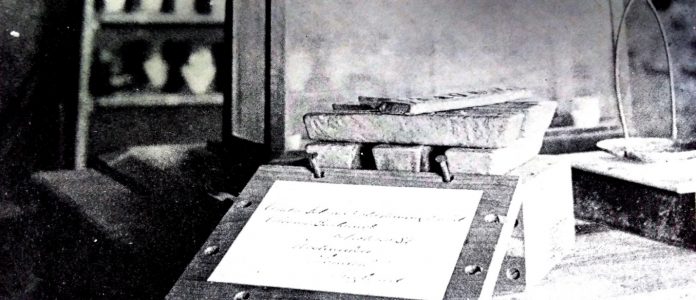Geological exploration was officially conducted in 1725. The search for mineral ores was funded by The Amsterdam Chamber, Head Office of the Dutch West India Company. These gentlemen sent a certain Mr. Paulus Printz to the island, who had to perform soil research under the title of director mountain worker. After searching in vain on Curaçao and on Bonaire, he headed to Aruba and searched on the Cristalberg, dug a subterranean passage in Sero Colorado and sent barrels of stone containing ore as samples to Amsterdam. Only a minimal amount of gold and silver was found, so the decision was taken to discontinue the efforts by Printz. After three years of trudging through the rock-hard Aruban soil, he left Aruba again.
 Pic.2. The way in which alluvial gold was found by young Willem Rasmijn
Pic.2. The way in which alluvial gold was found by young Willem Rasmijn
 Pic.3. Geological map of the island
Pic.3. Geological map of the island
One hundred years later in March 1824 a gold rock was discovered in Rooi Fluit on the North coast, as one told by a 12-year old boy, Willem Rasmijn, who was looking after his father’s sheep there. Willem saw something sparkling on a spot washed out by the rain. His father not knowing what it was showed it to a merchant in Oranjestad. The latter realized that it was gold and offered the man $ 17.00 Rasmijn accepted and the merchant later sold it for $ 70.00.
The rumor spread very rapidly, of course, and every boy and girl who tended sheep, as was the custom, started searching the arroyos (dry beds of rivulets). Soon an Indian girl found a piece of gold at Rooi Daimari.
 Pic.4. How gold is found in quartzdiorite
Pic.4. How gold is found in quartzdiorite
After five months more than 25 pounds of gold had been collected.  Pic.5. Map of the island showing gold mining zones.
Pic.5. Map of the island showing gold mining zones.
Understandably, On July 1824 J. Thielen who was the islands Commander at the time, immediately took measures by informing the Governor P.R. Cantz`laar at Curacao, that gold has been found on Aruba. Two lumps of gold -ore was send as proof. The legend of the Aruba gold turned out to be reality. For the bootless blows of Printz`s sledge hammer a century ago.
The regions where gold was found were declared “not free”. Soldiers came to guard these terrains. Daimari, Lagabai ( Rooi Fluit), Wacobana, Arikok en Hadicurari were the most important places where gold was found. Most of it was alluvial, that came to the surface as native gold. When systematical research was introduced later on, gold-ore was also found in the western part of Aruba, especially at Tibushi.
At first everyone was allowed to look for gold, providing the gold was handed over to the government against a set price. In 1854 this system was abandoned and gold-mining was granted to a concession-holder.
Primitive gold- mining
In looking for gold one went about in a very primitive way. Everywhere clay was dug out from the arroyos and put to dry in the sun. Then the hardened parts were beaten into small pieces. If there was any gold, the bigger pieces would naturally come free and when this happened, one knew that there were possibly smaller pieces as well. To find these, the finely beaten clay was ground on a large piece of sailcloth, after which the wind blew off the sand, leaving behind the small pieces of gold.
Another system was to dilute the clay with water in large vessels, so that the gold sank to the bottom.
When commercial firms came in 1854, machinery was imported, among which crushing mills.
Smelting Works
In 1872 the Aruba Island Gold Mining Company Ltd. Built a large smelting works at Bushiribana on the North coast, for the ore that was being mined at Cero Plat and in its surroundings. This smelting works was in use for only ten years, but its construction was so solid, that ruins thereof at the North coast are still quite impressive.
A next concession-holder, Aruba Gold Concessions Ltd., worked principally in the center of the island and had a smelting works built at Balashi in 1899, of which not only crumbling walls, but even kettles and ovens are still left.
A last attempt
In 1916 gold-mining in Aruba had to be ceased; due to the First World War the materials required for the purification of the ores could no longer be had. During the 92 years since the discovery of gold in 1824, 2962.50 pounds of gold have been exported. An attempt made in 1946 to resume gold-mining in a modern way, proved however not to be profitable.
Yet there still is gold in the Aruba`s soil, even though you would have to be very lucky to find some on your excursions on the island. q
Discover an Aruba which no other could share with you. Discover and explore and take your experience home with you. Our renowned indigenous and educative session has been entertaining curious participants for decades. Mail us at etnianativa03@gmail.com to confirm your participation. Our facilities and activities takes place close to your hotels area. 















